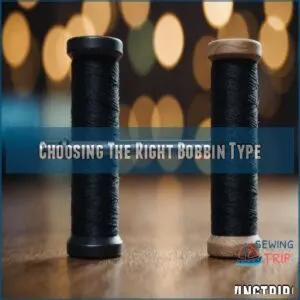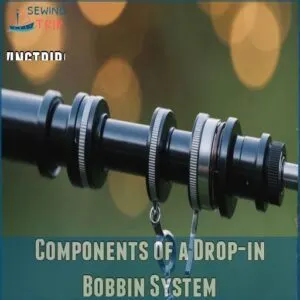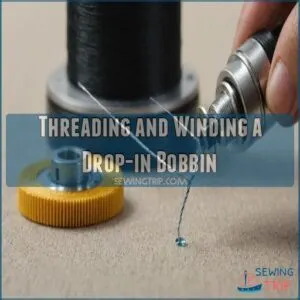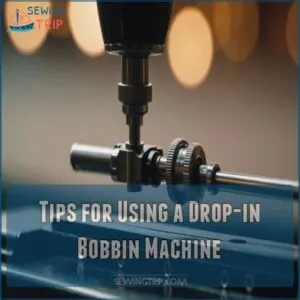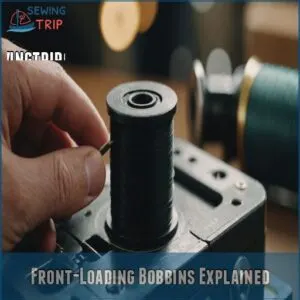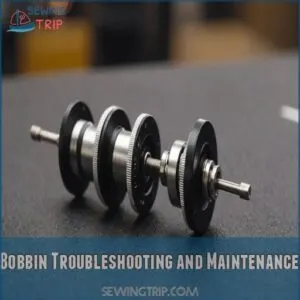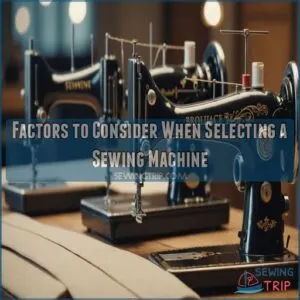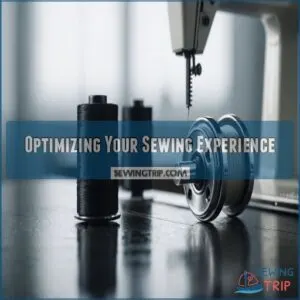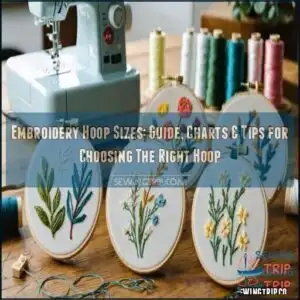This site is supported by our readers. We may earn a commission, at no cost to you, if you purchase through links.
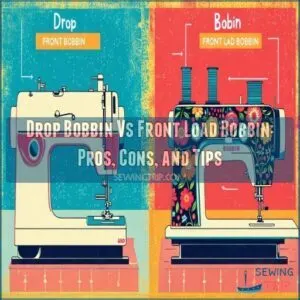 Choosing between a drop bobbin vs front load bobbin? You’re not alone!
Choosing between a drop bobbin vs front load bobbin? You’re not alone!
Think of it like this: a drop bobbin‘s like a quick-change artist – super easy to thread and monitor.
Front-loading bobbins are often cheaper, but might need a bit more fiddling.
You’ll find that each has its quirks; some sewers swear by one, others by the other.
The best choice depends on your sewing style and priorities.
Want to know which one’s really right for you, and how to troubleshoot common bobbin issues?
There’s more to discover…
Table Of Contents
Key Takeaways
- You’ll find drop-in bobbins are user-friendly, offering easy monitoring and quick thread changes through a clear compartment.
- Front-loading bobbins, although more traditional and requiring a bit more skill, provide reliable tension control and are great for handling thicker fabrics.
- Choosing between drop-in and front-loading bobbins depends on your sewing style and machine compatibility; each has distinct advantages that can suit different needs.
- Regular maintenance and proper threading are crucial for both types to ensure smooth sewing operations and prevent jams or thread tangling.
Choosing The Right Bobbin Type
When you’re picking the right bobbin type for your sewing adventures, it’s like choosing between a trusty old friend and a shiny new gadget.
Front-loading bobbins might feel like a gentle nod to the past, while drop-in bobbins are the quick and easy pals of modern sewists, ready to keep your creative projects rolling smoothly.
Front-Loading Bobbin Pros and Cons
At times, choosing a front-loading bobbin can feel like picking the right flavor of ice cream for a hot day.
They’re reliable in avoiding thread tangles and bobbin jams.
However, they can be tricky with 1. Needle compatibility, 2. Older sewing machine models, 3. Limited fabric types, and 4. Tedious bobbin troubleshooting.
Drop-in Bobbin Pros and Cons
Feeling puzzled about bobbins?
While front-loading bobbins have their day, drop-in bobbins shine for their ease of use and reliability.
They’re great for quick thread changes but watch out for jams.
Plus, finding the right bobbin size can be tricky.
Here’s a handy table!
| Pros | Cons |
|---|---|
| Easy to thread | Prone to jamming |
| Quick thread changes | Higher cost |
| Fewer threading errors | Limited compatibility |
| Durable design | Challenging maintenance |
| Convenient, clear cover | Limited accessory fit |
Key Differences Between Bobbin Types
So, you’ve weighed the pros and cons of drop-in versus front-loading bobbins.
The biggest difference? Accessibility!
Drop-in bobbins are super easy to swap out—think "pop and go."
Front-loading bobbins require a little more finesse; you’ll need to open a case.
Both work great, it’s just a matter of personal preference and your machine type.
Choose what feels right for you and your sewing speed.
Happy sewing!
How Drop-in Bobbins Work
When you’re sewing, drop-in bobbins make your life easier by popping right into a clear compartment below the needle plate, so you can keep an eye on the thread without losing track of your project.
Imagine your bobbin as a tiny lifeguard in plain sight, always ready to save you from tangles and thread disasters!
Components of a Drop-in Bobbin System
Peeking through the clear cover of your sewing machine, the drop-in bobbin nestles snugly under the needle plate.
Some models, like the Singer M1150 sewing machine with top drop-in bobbin, make it especially easy to check the bobbin thread supply without wrestling with the machine. When choosing a sewing machine with a top drop-in bobbin, understanding types of bobbins is crucial for optimal performance.
Top drop-in bobbin models are designed for convenience.
The bobbin holder keeps everything in place while the bobbin case maintains proper thread tension.
It’s one of those sewing machine accessories you’ll definitely appreciate!
Threading and Winding a Drop-in Bobbin
Once you’re familiar with the components, threading and winding a drop-in bobbin isn’t rocket science.
Keep these steps in mind:
- Wind the bobbin evenly, ensuring tight coils.
- Insert it correctly with the thread going in the right direction.
- Adjust bobbin tension to avoid thread breakage.
- Check for jams, keeping your bobbin case clean.
Tips for Using a Drop-in Bobbin Machine
A drop-in bobbin machine can be your sewing sidekick, ensuring smooth stitches if you follow a few tips.
First, always insert the bobbin correctly—this prevents jams.
Adjust tension settings to match your fabric.
Choose the right needle to prevent skips and snags.
Regular maintenance keeps your machine in tip-top shape.
Troubleshooting bobbin issues early on saves future headaches.
Front-Loading Bobbins Explained
When you’re working with front-loading bobbins, you load the bobbin through a little door at the front of the machine, which might remind you of those secret compartments in a spy movie.
They might seem old-school, but front-loading bobbins are still treasured for their reliability and ease of use, making them a dependable choice for many sewing enthusiasts.
How Front-Loading Bobbins Are Inserted
Sliding open the bobbin cover gently, you’ll first remove the bobbin case to expose where the magic happens in those front-loading sewing machines.
Place your bobbin into the case, making sure the thread unwinds counterclockwise.
Tuck it back, ensuring it clicks into place.
Your thread should be snug—think Goldilocks, not too tight, not too loose.
Ready, set, sew!
Advantages of Front-Loading Bobbins
Now that you’ve mastered inserting a front-loading bobbin, let’s explore its perks! You’ll appreciate the improved Bobbin Access; it’s easier to see and manage your bobbin thread. If you’re looking for compatible front load bobbin sewing machines, you can find a range of options here for front load sewing machines. Plus, many find the visual access helps with Thread Tension adjustments. It’s a simple system, great for beginners!
- Easier bobbin changes.
- Improved visibility of the bobbin thread.
- Often better Sewing Machine Compatibility with various machines.
- Simple Bobbin Winding process.
- Generally, better Ease of Threading.
Disadvantages of Front-Loading Bobbins
While front-loading bobbins have their perks, they aren’t without a few bumps.
Imagine this: you’re hunched over, struggling with difficult threading and limited access, only to be greeted by thread tangling or bobbin jams, which can often be resolved by addressing common bobbin problems solutions.
These quirks, like case wear and sewing machine compatibility issues, can turn a sewing session into a test of patience.
It’s a classic sewing machine drawback!
Bobbin Troubleshooting and Maintenance
When your sewing machine’s bobbin acts up, it might feel like it’s plotting against your next masterpiece, but don’t forget that bobbins are essential for creating a lock stitch, and sewing without one can lead to weak stitches, as seen in tips for using a sewing machine without a bobbin, but fear not—most bobbin issues have simple solutions.
With a bit of regular maintenance and some easy troubleshooting, you can keep both drop-in and front-loading bobbins running smoother than a well-oiled machine.
Common Issues With Front-Loading Bobbins
Tired of dealing with front-loading bobbins? Thread breakage, bobbin jams, and tension problems are common headaches.
Imagine you’re all set for sewing, then bam—bobbin winder issues strike! Keep an eye out for needle damage too.
Understanding how to wind a bobbin with a bobbin winder tool is crucial for correct bobbin thread insertion. Make sure your sewing machine’s bobbin thread is correctly wound and inserted. Even beginner sewing machines have quirks, but a little care keeps everything running smoothly.
Common Issues With Drop-in Bobbins
You’ve battled front-loading bobbin frustrations, but drop-in bobbins have quirks too. Keep these gremlins at bay:
- Bobbin jamming can halt progress; make sure bobbins are snug and smoothly wound.
- Thread tangling often means it’s time to recheck threading paths.
- Watch for case breakage, especially with tough fabrics.
- Tension problems? Adjust settings to prevent bobbin thread chaos!
Cleaning and Maintaining Bobbin Cases
Let’s take a closer look at keeping your bobbin cases in tip-top shape.
Regular cleaning with bobbin case cleaning tools is essential.
Lint removal methods, like a small brush or a gentle vacuum, sweep away debris.
A drop of oil helps smooth operation, extending your bobbin case lifespan.
To keep your bobbin thread dancing right, always turn off your sewing machine before inserting the bobbin. Maintain your drop-in bobbin sewing machine with frequent checks to keep your bobbin thread dancing right.
Factors to Consider When Selecting a Sewing Machine
When picking a sewing machine, you’ll want to think about the type that fits your bobbin needs, stitch options, and even how easy it’s to get it serviced locally.
Don’t let your dream quilting project go off-track because you didn’t check if your machine’s presser feet or stitches are a match for your plans!
Machine Type and Bobbin Compatibility
Before buying a sewing machine, check bobbin compatibility!
Different sewing machine brands use various bobbin types and sizes.
Vintage machines often need specific bobbins; newer computerized sewing machines might use drop-in bobbins, while mechanical sewing machines frequently use front-loading ones.
Consider your bobbin thread needs.
To achieve perfect stitches, ensure your bobbin case is properly aligned and snaps into place. Knowing the correct method for threading the bobbin case is crucial. Knowing your machine’s bobbin case requirements guarantees smooth sewing.
It’s like finding the right key for your lock – simple but important!
Available Stitch and Presser Feet Options
Ever wonder about all those stitch options.
Choosing the right sewing machine means spotting the perfect presser feet, which can be found at various online stores like sewing machine products.
Consider these three essentials:
- Stitch types: What special stitches does it offer?
- Foot compatibility: Are all the presser feet you need included?
- Sewing techniques: Can it handle your drop-in bobbin and bobbin thread dreams?
Ready to thread creativity?
Local Servicing Availability
Considering stitch options is fun, but don’t overlook local servicing availability.
A machine needs occasional TLC.
Can you find a local technician nearby who knows the Singer Quantum Stylist 9960 well?
Check service center locations and compare repair costs.
Warranty coverage details matter, too.
Keeping your drop-in bobbin sewing smoothly could hinge on finding reliable local service.
Optimizing Your Sewing Experience
When you’re trying to optimize your sewing experience, picking the right needle and thread is as important as choosing your favorite comfy chair for a long day of sewing.
Pay attention to proper thread tension and winding techniques to keep your sewing smooth and efficient, because no one wants a tangled thread mess!
Choosing The Right Needle and Thread
Next up, let’s chat needles and threads—picking the right match is as tricky as finding the perfect pair of shoes.
Consider these four tips to get it spot on:
- Needle Size: Match it to your fabric weight.
- Thread Type: Make sure it’s compatible with the fabric.
- Stitch Length: Adjust for material type.
- Tension Settings: Fit them to your drop-in bobbin setup.
Got any sewing notions yet?
Proper Thread Tension and Winding Techniques
Optimize your sewing by mastering thread tension and winding.
Imagine your drop-in bobbin like a puzzle piece fitting perfectly.
Make sure you wind evenly and adjust bobbin tension to prevent snags.
Whether you’re using a Brother CS6000i, Janome HD3000, or Juki HZL-F300, balance is key.
For a smoother sewing experience, consider investing in a drop bobbin sewing machine from Everysimply online store.
A little humor goes a long way—think of it as threading life’s fabric smoothly.
| Task | Machine | Tip |
|---|---|---|
| Thread Tension Basics | Brother CS6000i | Keep tension balanced |
| Winding Consistency | Janome HD3000 | Wind evenly |
| Bobbin Tension | Juki HZL-F300 | Adjust for smooth operation |
| Prevent Snags | Drop-in bobbin | Check bobbin thread path |
| Even Winding | All machines | Use steady speed during winding |
Tips for Smooth and Efficient Sewing
You’ve mastered thread tension basics, now let’s make sewing smoother by following essential best sewing machine beginner tips, such as setting up your sewing machine workspace for proper ergonomics and good lighting.
Keep your Bernina 330 humming with regular sewing machine maintenance.
A little oil goes a long way!
Make sure your bobbin thread and fabric get along by following a smart fabric selection guide and using the right needle types guide.
An extension table and automatic buttonhole can make sewing a breeze!
Frequently Asked Questions (FAQs)
What is the difference between front-loading and drop-in bobbins?
Like comparing apples to oranges, front-loading bobbins slide into a compartment on the machine’s front, often needing a bit more finesse.
Drop-in bobbins, however, sit under the needle plate, making it easy-peasy to monitor thread use.
Are front load bobbins a good choice for a sewing machine?
Front-load bobbins are reliable and sturdy, especially for heavy-duty sewing.
They fit well in older machines and offer consistency with thicker fabrics.
Though they take practice to replace, they’re a dependable choice if you’re hands-on.
What is a drop-in bobbin sewing machine?
Dropping dreams of fiddly yarn, a drop-in bobbin sewing machine lets you pop the bobbin inside the needle plate’s clear compartment.
This design makes it easy to see thread status, saving you time and tantrums during sewing.
How does a drop-in bobbin work?
You should start by checking your sewing machine’s instructions for the correct needle size and type, as outlined in guides on sewing machine bobbin problems, to ensure you’re using the right one for your fabric, then pop a drop-in bobbin directly under your sewing machine’s needle plate.
It sits snugly in a clear case, letting you keep an eye on thread supply and reducing those dreaded tangles.
It’s super convenient!
Is a drop-in bobbin better?
Choosing a drop-in bobbin can simplify your sewing projects with quick changes and easy viewing.
However, they might jam more easily if inserted incorrectly.
Kind of like slipping on a banana peel—funny but avoidable!
What is a drop in a bobbin?
Imagine a treasure chest!
A drop-in bobbin‘s like that; it’s a handy compartment under your sewing machine’s needle plate.
You simply drop the bobbin in—easy peasy!
It’s quick, convenient, and lets you easily monitor your thread supply.
Is a front or top load bobbin better?
Both front and top-load bobbins have their perks.
Top-load bobbins offer easy monitoring and quick changes.
While front-load bobbins may handle tension better.
Your choice depends on your sewing needs and machine compatibility.
Do all sewing machines use the same bobbins?
Not all sewing machines use the same bobbins.
Bobbins come in various sizes and styles, like Class 15 or L-type.
Always check your machine’s manual to avoid a sewing calamity!
What are the key differences in machine accessibility?
Think of machine accessibility like a well-organized toolbox.
A drop-in bobbin feels more open, with quick access and fewer hurdles.
In contrast, front-load bobbins can seem like a puzzle, requiring more steps and patience.
How does bobbin style impact sewing speed?
Bobbin style can change your sewing speed dramatically.
A drop-in bobbin makes setup speedy and straightforward, reducing downtime for bobbin changes.
Still, this ease of use might slightly reduce efficiency compared to front-load bobbins with frequent adjustments.
Are there specific thread types for each bobbin?
Imagine threading your machine perfectly, only to find you’re using the wrong thread!
While almost any sewing thread can fit a bobbin, using high-quality polyester or cotton thread helps to guarantee smooth sewing and reduces annoying snags.
Which bobbin type is more beginner-friendly?
You’ll find drop-in bobbins more beginner-friendly.
They’re easier to thread and let you see the thread supply through a transparent cover.
Just pop the bobbin in and close the lid—no wrestling required!
How does bobbin type affect stitch quality?
Neither bobbin type inherently impacts stitch quality. Proper threading, tension, and needle choice are key. A jammed bobbin, regardless of type, ruins your stitches!
Conclusion
Starting your sewing journey is like picking the perfect pair of shoes; comfort and function matter.
Whether you choose a drop bobbin or front load bobbin, it’s about matching your style to your needs.
Drop bobbins are quick to swap and watch, while front-loaders might cost less but need some finesse.
Understanding both helps you troubleshoot and maintain your gear effectively.
Now, apply these insights to find what fits your sewing groove best!

